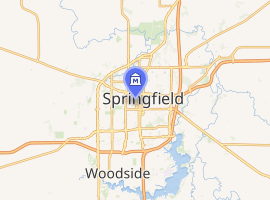Illinois State Museum
The Illinois State Museum features the life, land, people and art of the State of Illinois. The headquarters museum is located on Spring and Edwards Streets, one block southwest of the Illinois State Capitol, in Springfield. There are three satellite locations: Dickson Mounds in Lewistown, the Lockport Gallery in Lockport, and the ISM's Research and Collections Center in Springfield.

| |
| Established | 1877 |
|---|---|
| Location | 502 South Spring Street Springfield, IL 62706 (United States) |
| Coordinates | 39.7967°N 89.6554°W |
| Type | Art museum, history museum, natural history/anthropology museum [1] |
| Director | Cinnamon Catlin-Legutko |
| Website | www |
In addition to natural history exhibits, the main museum in Springfield focuses on the state's cultural and artistic heritage. Exhibits include local fossils and mining, household displays from different historic periods, dioramas of Native American life, archaeological and ethnographic artifacts, and a collection of glass paperweights.
Due to Illinois budgetary challenges, the Illinois State Museum was temporarily closed in October 2015—June 2016.[2][3][4] After adopting an admission fee, the flagship museum reopened on July 2, 2016. The fee is waived for children and veterans. The Chicago Gallery and the Southern Illinois Artisans Gallery were not reopened.
Dickson Mounds
The Dickson Mounds Museum, located in Lewistown, is an archaeological museum of Illinois's Native American history. Exhibits include hands-on displays, dioramas, photos and artifacts that depict area cultures from the Ice-Age to the 19th century. The museum grounds comprise 230 acres (0.93 km2) including the Eveland Village, the excavated remains of three early Native American buildings.
Lockport Gallery
The Lockport Gallery, located in Lockport, features changing exhibitions of past and contemporary Illinois artists and artisans. The gallery is located in the 1850 Norton Building, which was originally used to house grain, a supply store, and a dormitory for canal crews. The building functioned as a grain-processing facility until the 1950s. The gallery was temporarily closed in October 2015.
Southern Illinois Art & Artisans Center
The main gallery of the Southern Illinois Art & Artisans Center is the Southern Illinois Art Gallery, which features changing exhibits of contemporary and history Illinois artists, as well as fine art, decorative art and ethnographic art from the collections of the Illinois State Museum. The center also features the Southern Illinois Artisans Shop, which sells fine crafts from Illinois artisans and offers artisan workshops, demonstrations, and special arts and crafts events. The center is located in Whittington, near Rend Lake. The center was closed in October 2015, and has not been reopened.
ISM Chicago Gallery
The ISM Chicago Gallery, located in the James R. Thompson Center in Chicago, featured changing exhibits of fine and decorative arts. The gallery was closed in October 2015, and was not reopened.
History
The Illinois State Museum was founded on May 25, 1877 as a showcase within the sixth Illinois State Capitol in Springfield, which was completed at that time. Amos Henry Worthen was first curator. As the state's government grew, the museum collection was moved from the Capitol Building to the newly constructed Centennial Building, now known as the Michael Howlett building, in 1923.
With continued growth of its collections, and the need to have a dedicated location in Springfield for tourists and school groups, the state began construction of its first purpose-built state museum in 1961. The building was completed in 1962. This building is the current Illinois State Museum.
In the 1980s and 1990s, the Illinois State Museum expanded to also open four satellite museums. The Dickson Mounds Museum, near Lewistown, Illinois, specializes in the anthropology of the Native Americans of the Illinois River valley, while the museums in Chicago, Lockport, and Rend Lake largely contain rotating exhibitions of Illinois-based fine arts and crafts.
Governance
Illinois Governor Jim Edgar, by executive order in 1995, made the State Museum part of the new Illinois Department of Natural Resources (IDNR).
The Illinois State Museum is, as of January 2019, a division of IDNR and consists of four museum facilities: the flag ship Museum and the Research and Collections Center in Springfield, Dickson Mounds in Lewistown, and the Lockport Gallery in Lockport. The Museum has its own 11-member board, appointed by the Governor of Illinois with the advice and consent of the Illinois State Senate.
Mission statement
The Illinois State Museum is charged by state law with the responsibility "to collect and preserve objects of scientific and artistic value, representing past and present fauna and flora, the life and work of man, geological history, natural resources, and the manufacturing and fine arts; to interpret for and educate the public concerning the foregoing."[5]
Repatriation of objects to Australia
In late October 2019 the first collection of many sacred artifacts belonging to Indigenous Australians held in US museums were returned by the Illinois Museum. As the first phase of a larger project, 42 Aranda and Bardi Jawi objects were sent first to Sydney, before being returned to central Australia, from where they were taken around 1920.[6]
References
- Illinois State Museum: About, ARTINFO, 2008, retrieved 2008-07-28
- Chicago Tribune (25 June 2015). "Illinois State Museum system faces closing in state budget showdown - Chicago Tribune". chicagotribune.com. Retrieved 30 May 2016.
- Chicago Tribune (5 August 2015). "Non-binding vote says no to closing Illinois state museum". Daily Southtown. Retrieved 30 May 2016.
- Doug Finke; State Capitol Bureau. "Overflow crowd protests Illinois State Museum closure". The State Journal. Retrieved 30 May 2016.
- 20 ILCS 801/1-25(19), state law accessed May 1, 2008
- Beavan, Katrina. "Sacred Indigenous artefacts handed back to Aranda and Bardi Jawi elders after 100 years in US". ABC News. Australian Broadcasting Corporation. Retrieved 7 November 2019.